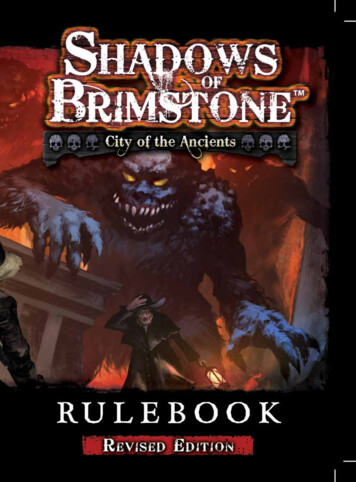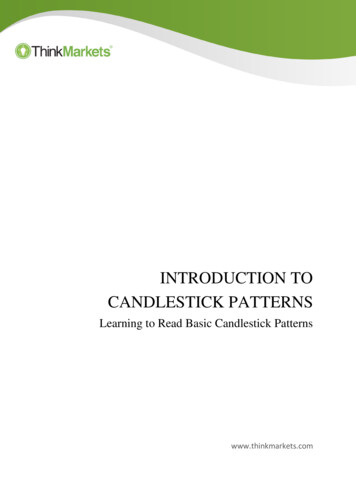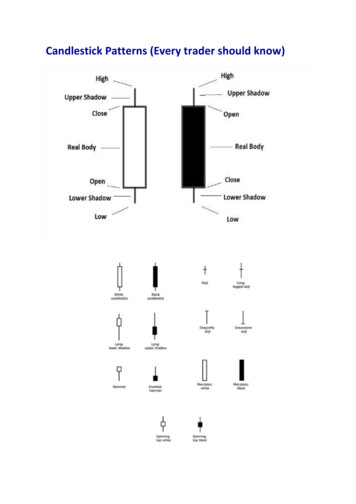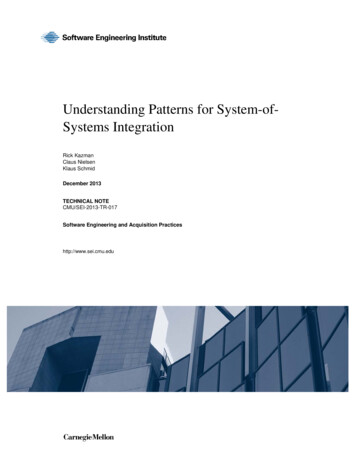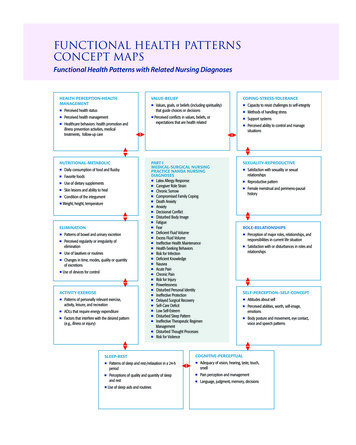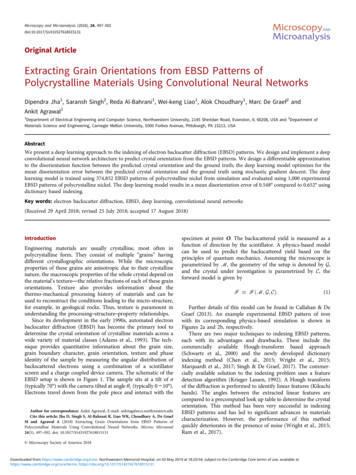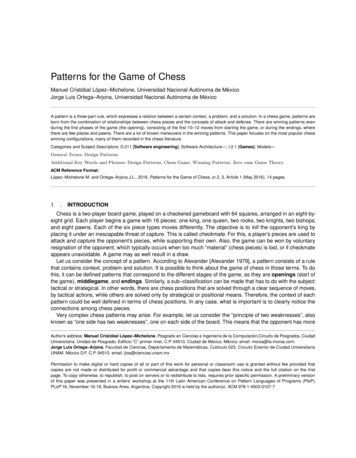
Transcription
Patterns for the Game of ChessManuel Cristóbal López–Michelone, Universidad Nacional Autónoma de MéxicoJorge Luis Ortega–Arjona, Universidad Nacional Autónoma de MéxicoA pattern is a three-part rule, which expresses a relation between a certain context, a problem, and a solution. In a chess game, patterns areborn from the combination of relationships between chess pieces and the concepts of attack and defense. There are winning patterns evenduring the first phases of the game (the opening), consisting of the first 10–12 moves from starting the game, or during the endings, wherethere are few pieces and pawns. There are a lot of known maneuvers in the winning patterns. This paper focuses on the most popular chesswinning configurations, many of them recorded in the chess literature.Categories and Subject Descriptors: D.211 [Software engineering]: Software Architecture—; I.2.1 [Games]: Models—General Terms: Design PatternsAdditional Key Words and Phrases: Design Patterns, Chess Game, Winning Patterns, Zero–sum Game TheoryACM Reference Format:López–Michelone M. and Ortega–Arjona J.L., 2016. Patterns for the Game of Chess. jn 2, 3, Article 1 (May 2016), 14 pages.1. INTRODUCTIONChess is a two-player board game, played on a checkered gameboard with 64 squares, arranged in an eight-byeight grid. Each player begins a game with 16 pieces: one king, one queen, two rooks, two knights, two bishops,and eight pawns. Each of the six piece types moves differently. The objective is to kill the opponent’s king byplacing it under an inescapable threat of capture. This is called checkmate. For this, a player’s pieces are used toattack and capture the opponent’s pieces, while supporting their own. Also, the game can be won by voluntaryresignation of the opponent, which typically occurs when too much “material” (chess pieces) is lost, or if checkmateappears unavoidable. A game may as well result in a draw.Let us consider the concept of a pattern. According to Alexander [Alexander 1979], a pattern consists of a rulethat contains context, problem and solution. It is possible to think about the game of chess in those terms. To dothis, it can be defined patterns that correspond to the different stages of the game, as they are openings (start ofthe game), middlegame, and endings. Similarly, a sub–classification can be made that has to do with the subject:tactical or strategical. In other words, there are chess positions that are solved through a clear sequence of moves,by tactical actions, while others are solved only by strategical or positional means. Therefore, the context of eachpattern could be well defined in terms of chess positions. In any case, what is important is to clearly notice theconnections among chess pieces.Very complex chess patterns may arise. For example, let us consider the “principle of two weaknesses”, alsoknown as “one side has two weaknesses”, one on each side of the board. This means that the opponent has moreAuthor’s address: Manuel Cristóbal López–Michelone, Posgrado en Ciencias e Ingeniería de la Computación,Circuito de Posgrados, CiudadUniversitaria. Unidad de Posgrado, Edificio “C” primer nivel, C.P. 04510, Ciudad de México, México. email: morsa@la-morsa.com;Jorge Luis Ortega–Arjona, Facultad de Ciencias, Departamento de Matemáticas, Cubículo 023, Circuito Exterior de Ciudad UniversitariaUNAM. México D.F. C.P. 04510. email: jloa@ciencias.unam.mxPermission to make digital or hard copies of all or part of this work for personal or classroom use is granted without fee provided thatcopies are not made or distributed for profit or commercial advantage and that copies bear this notice and the full citation on the firstpage. To copy otherwise, to republish, to post on servers or to redistribute to lists, requires prior specific permission. A preliminary versionof this paper was presented in a writers’ workshop at the 11th Latin American Conference on Pattern Languages of Programs (PloP).PLoP’16, November 16-18, Buenos Aires, Argentina. Copyright 2016 is held by the author(s). ACM 978-1-4503-0107-7
space in the center, so you can go from one side to another board faster than your opponent. Sooner or later, thestronger side can attack a weak position, and next, turn to the second one, and then to return to the first one.Most of the times, the opponent is not able to arrive in time to defend both weak positions. The expression of thisprinciple is simple, but categorized as a pattern, it does not seem to be so simple.Patterns are about design and interaction of objects, as well as providing a communication platform with reusablesolutions to commonly found challenges. 1 So, patterns for the game of chess are general purpose abstractions ofproblems found when properly playing chess. A good collection of chess patterns may reduce complexity andsolutions to problems encountered in chess, making them easier to understand, so we could have a selection oftested solutions to work with.This paper describes some of the most well known and popular chess patterns, such as the “Tarrasch formula”,the fork of a knight, the rule of square, an so on.2.2.1. SOME POPULAR CHESS PATTERNS“TARRASCH ’ S F ORMULA ”The most popular game endings –and the more difficult to play well– are the rooks endings. They appear whenall the other pieces have gone, and remains only rooks and pawns. Frequently in this type of game ending, there isan extra pawn for one of the players, and most of the time, this pawn is a passed one, that is, there is no opponentpawn along the same column. There are a lot of tips and recommendations for both players: the one with theadvantage, and the one who has to deal with an inferior game. Polish grandmaster Siegbert Tarrasch (1862-1934),enunciated a very clever rule for manage these type of endings.[Also known as] - rooks should be placed behind passed pawns –either yours or your opponent’s[Example] - In the game Mecking – Korchnoi, 1974 2 , Black has a passed pawn column “a”, in a typical rook andpawns ending. This is a clear example of the Tarrasch’s formula, in which the defender must use it to save thegame (finding a draw):Fig. 1. Mecking–Korchnoi, 1974. An example of the “Tarrasch’s Formula”. The white rook goes behind the passed black pawn in column “a”[Context] - In chess endings, when queens, bishops and knights are gone, the passed pawns (those who have noenemy pawns in front of them) are looking to become through promotion to a stronger chess piece.[Problem] -The weaker player must stop the passed pawns of the opponent.[Solution] - Place a rook behind a passed pawn. “In complicated rook endings the most important rule is one laid1 http://www.dofactory.com/net/design-patterns2 http://www.chessgames.com/perl/chessgame?gid 1082252Patterns for the Game of Chess — Page 2
down by the author: The rook’s place is behind the passed pawn; behind the enemy pawn in order to hold it up,behind one’s own in order to support its advance”. [Tarrasch 1988] In each case, the rook gets more squares assoon the passed pawn makes a move.[Structure] - The participants in this pattern are rooks and pawns. Often, one of the players has an extra passedpawn.[Dynamics] - Figure 2 shows a chess diagram with the maneuver of the defending side.Fig. 2. Tarrasch’s formula in action[Known uses] -The Tarrasch’s formula is used in some of the games as follows:Fig. 3. In the game Unzicker–Lundin, 1954, the position was a simple draw placing the black rook behind the passed pawn.[Consequences] - Many rooks game endings work around the minimal advantage of a passed pawn. The playerwith the advantage should try to put his rook behind his own passed pawn, to support its advance. The defendershould attempt to do the same. A rook behind the enemy pawn is a secure way to find a draw in an inferior position.Many rooks endings can be saved using this formula 3 , because the defender can get more space (squares) assoon the passed move moves. On the other hand, the player with the advantage will win also more space if his/herrook is behind his own pawn, again, as soon the pawn can move.[Variants] - Tarrasch’s formula has some practical exceptions (look at known uses). For instance the game Kharlov– Morozevich, 1995 4 , where the suggested move by Tarrasch’s formula 1. . Rb7 is only enough for a draw (Figure3 Endingsof one rook and pawns are about the most common sort of endings arising on the chess board. Yet, though they do occur so often,few have thoroughly mastered them. They are often of a very difficult nature, and sometimes while apparently very simple, they are in realityextremely intricate. - José Raúl Capablanca4 http://www.chessgames.com/perl/chessgame?gid 1099966Patterns for the Game of Chess — Page 3
4).Other games in which there are variants of the Tarrasch’s formula are:—Yuri Averbach [Averbakh 1966] indicates that the rule is correct usually when both rooks, the one who has theadvantage and the defending side, are over the pawn [Nunn 1993].—But when the pawn is blocked by the opponent’s king, the rook of the same color must be usually better defeningthe pawn from the side.[Emms 2008]—At the ending of rook and pawn vs. rook, if the pawn has not passed in the fourth row, the best place for the rookis in front of the pawn. [Dvoretsky 2006]—On a similar note, Cecil Purdy says that the rook is better behind the pawn if it has reached at least the fifthrow. [Purdy 2003] Again the reason was outlined before: the rook gets more squares as soon the passed pawnmakes a move. According to Purdy, at the fifth row, the rook behind the pawn is getting more powerful as soonthe pawn is moved.Fig. 4. Here is a wrong application of the Tarrasch’s formula. Black rook behind his own pawn is not enough to win (square “b7”, marked withred). The right maneuver is to place the Black rook in the square “e5” (marked with yellow). The reason behind this move takes account of theopponent King (in this case the White King), who is cutted off from the action with the Black Rook in e5.2.2.D EFENDER REMOVALChess master, very often, accommodate their forces (pieces), in such a way most of the pieces defend eachother. A very common tactical trick against this strategic idea is to eliminate a defender of another piece (could beeven a pawn). As soon the defender is taken, the new undefended piece can be taken easily. This is a way toensure material advantage.[Example] In the next position (see next figure), Black Bishop defends the Black rook in “f5”. The procedure to wina piece is to remove the defender to take the piece defended.[Context] -Pieces under attack that are defended by other pieces as well.[Problem] - One of the player is attacking an opponent piece who is defended another piece too.[Solution] - Remove the defender of the attacked piece to take it (the defended piece) the next move.[Structure] - This is a general pattern in which many of the chess pieces could be involved. Frequently pieces aredefending with each other, so the removal of a defender is a common tactical procedure.[Dynamics] - The next diagram shows the maneuver of the defender removal pattern.Patterns for the Game of Chess — Page 4
Fig. 5. In this case, the bishop of h7 protects the rook in f5. The maneuver implies to sacrifice the white rook with 1. Rxh7! and continue with2. Kxf5, winning the ending.Fig. 6. First part: Defender removal.[Variants] - There are a lot of variants of this pattern, but the principle is the same: remove the defender to takethe piece defended.[Known uses] - This is a very common maneuver and there are lots and lots of examples in the master chesspractice.[Consequences] - Applying this pattern frequently takes the advantage or at least, gives a better chance to thePatterns for the Game of Chess — Page 5
Fig. 7. Second part: Capture the second piece already not defended.player who executes it. There is a drawback: this maneuver often simplifies the chess position so that sometimesthere is not enough material to win.Patterns for the Game of Chess — Page 6
[Solved example] In the game Lukin – Timoshenko, Spartakiad, URS 1979, (see Figure 8), White defined thegame removing the Black defenders in a very effective way: 19. Rxd8! First, get rid of the best defender of theBlack side. 19. . Qxd8 20. Qh4 Bc4 21. Rxf6! 21. . Bxe2 Now remove the second best defender of Black position.22. Rh6! f6 23. Bxf6! gxf6 24. Rxh7 Kg8 25. Qh6 Rc7 26. Qg6 Kf8 27. Rh8 Ke7 28. Nd5 1-0Fig. 8. White to play. Lukin – Timoshenko, Spartakiad, URS 1979: A good example of removing the best defenders of Black position.2.3.T HE GREEK GIFTThis tactical theme was inspired in the Horse tale, from the Trojan War about the subterfuge that the Greeksused to enter the city of Troy and win the war. In chess the player who is attacking sometimes can find a verysubtle configuration of pieces that may start a strong attack with a sacrifice of a bishop against the opponent King.The sequence of movements of the attacking side are really easy to follow and the defender side many times areunable to deal with the aggresive sacrifice.[Also known as] - Sacrifice in h7/h2[Example] - The next position has the fundamental elements of the greek gift:Fig. 9. Greek gift example.[Context] -The fundamental elements are (for white pieces) a bishop attacking h7, queen on d1 or e2 (to havethe chance to translate it to h5), and a knight on f3. Sometimes a white pawn in e5 is necessary to avoid a blackknight defending the castled opponent king.[Problem] - Destroy the black fortress to begin a strong attack against the opponent king.[Solution] - In the diagram position, 1. Bxh7 starts the attack. After 1. . Kxh7 2. Ng5 followed by 3. Qh5 buildsa very strong attack against a undefended king.Patterns for the Game of Chess — Page 7
[Structure] - This patterns occurs often when the opponent king is short–castled and the attackers pieces areagainst the king: a Bishop attacking the pawn in “h7”, a Knight dominating the “
06.11.2016 · Chess master, very often, accommodate their forces (pieces), in such a way most of the pieces defend each other. A very common tactical trick against this strategic idea is to eliminate a defender of another piece (could be even a pawn). As soon the defender is taken, the new undefended piece can be taken easily. This is a way to ensure material advantage. [Example] In the next position
